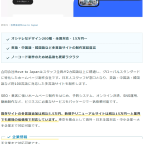What should I pay attention to when creating an English website? An easy-to-understand introduction to the differences between Japanese and English websites!
Basic Knowledge to Avoid Failure in English Website Production
Clarify the purpose of creating an English website
Set specific target users
How will you manage your English website? Do you update it? How often?
- Mirror Content: We recommend mirror content that is identical to the Japanese version in multiple languages. This method is recommended for those with low budgets and as little manpower as possible. You can either translate existing pages in the manual or use an automatic translation tool.
- We also offer a low-cost (from 29.000 yen) automatic translation tool → native translation check plan that combines the two.
- Static content: We focus on static content that does not need to be updated frequently, such as basic information or introduction of products and services, and create as much of it as possible during the initial site development.
- Reduce update frequency: Update less frequently and only update important information.
- FAQ format: Frequently asked questions, etc., are summarized in an FAQ format to reduce the frequency of updates.
Choose an appropriate domain name and server
Key Points for Selecting a Domain Name
- .com domains are common: They are the most recognized and trusted domains in the world. However, since it is a popular domain, there is a good chance that your desired domain name is already in use.
- Also consider ccTLDs for your target country: choosing a ccTLD (country specific top-level domain) for your target country, such as .co.uk (United Kingdom) or .fr (France), may give you an advantage in search engine optimization in that country.
- Match the brand name: Match the name of the company or service to unify the brand image and make it easy to remember.
- Choose short, easy-to-remember, relevant words: Domain names that are too long or too complex are difficult for users to remember and cause typos.
- Avoid hyphens as much as possible: Hyphens can cause typing errors and may not be recognized correctly by search engines.
Points to consider when selecting a server
- Fast and stable servers: Since users from all over the world will be accessing the site, it is important to choose a fast and stable server. Of course, you need to choose a server company in a country that matches your target users.
- Complete security measures: Choose a server with complete security measures to minimize the risk of hacking and data leakage.
- Multilingual support: Selecting a server that supports English as well as other languages will make it easier to support future multilingualization.
- Backup capabilities: Choose a server with regular backup capabilities to prevent data loss.
- Support system: Make sure you have a support system in place that can respond quickly to any problems that may arise.
Recommended server types
- Shared servers: These are relatively inexpensive servers that are easy for beginners to handle. Because many users share a server, performance may be inferior to other types.
- VPS servers: A form of virtual server rental that offers higher performance and more customization than shared servers.
- Dedicated servers: The most powerful and flexible, but also the most expensive, since you have exclusive use of one server.
Other Notes
- SSL Certificate: Consider installing an SSL certificate to increase the security of your site.
- CDN: Improve the display speed of your website by using servers distributed around the world.
- Global DNS: Use a global DNS for stable access from anywhere in the world.
Importance of Search Engine Optimization (SEO)
Separate URLs for each language
Set hreflang attribute
Keyword selection for each language
Compatible with search engines in various countries
Mobile-friendly design
Localized content
local SEO
Language selection (non-English speaking, Korean, Chinese)
Differences from the Japanese site and points to note
Different nuances of language and appropriate expressions
Different cultural backgrounds and designs
Differences between Japanese and Foreign Designs
aesthetic sense
color usage
How to perceive space
Multilingualization Strategies and Localization
localization
Common mistakes and countermeasures in English website production
misunderstanding caused by a literal translation
Lack of identification of target audience
Lack of SEO
Mistranslations due to direct translation and the importance of native checking
Mistranslations due to direct translation are very common in the production of English websites. Since the nuances of language and cultural backgrounds differ greatly between Japanese and English, a direct translation may not accurately convey the intended meaning or may lead to misunderstandings.
Checks by native speakers are critical to avoiding these problems. Native speakers have a deep understanding of the nuances of the language and its cultural background, and can modify the language to be natural.
Benefits of Native Checking
- Accurate meaning conveyance: Avoids mistranslations due to direct translation and accurately conveys the intended meaning.
- Natural expressions: Can be modified to be natural expressions as used by native speakers.
- Cultural contextualization: The wording can be modified to take into account the cultural context of each country.
- Improved appeal to target audience: Information can be conveyed more effectively by using wording and expressions that match the target audience.
Globalization and Regionalism in Design
Design is more than just visual expression; it is an important element that reflects culture and values. When designing from a global perspective, it is necessary to balance a universal design that appeals to users around the world in common with local characteristics that match the culture and tastes of each region.
globalization
- Commonality: Simple design that can be commonly understood by users around the world, based on a universal aesthetic
- Consistency: Designs that unify the brand image and create a similar impression around the world
- Efficiency: Reduce costs by minimizing design changes when deploying in multiple regions
regional character
- Cultural sensitivity: Understanding local culture, history, and values, and incorporating designs that match them.
- Language: Adjust text and fonts for different languages
- Colors: Some colors are preferred in different regions, others should be avoided
- Symbolism: incorporate symbols and motifs common to each region
Balance between globalization and localization
Striking a balance between globalization and localization is a very difficult task. However, by successfully combining the two, we can achieve a design that is acceptable to users around the world.
Slow loading speed and user experience
Website loading speed has a significant impact on user experience. Websites with slow display speeds can stress users, leading to higher abandonment rates and lower conversion rates.
Need for mobile compatibility
Mobile-friendly design is essential because of the increasing use of smartphones. There are many production companies that are not so particular about the design, such as those that are very particular about the PC screen and easy to view, but the mobile display is out of alignment or difficult to handle.
Three key points for successful English website production
- Clarify target users: It is important to clarify the countries and regions to which you want to deliver information, and to create content and designs that are tailored to your target users.
- Understanding of cultural differences: It is necessary to understand the culture, values, and business practices of each country, and to choose expressions and designs that match them.
- Thorough SEO: It is important to have a strong SEO strategy, including keyword selection, content optimization, and backlink acquisition, to ensure high rankings in search engines.
summary
English website production is essential for global expansion. To succeed, it is important to not only translate content for the target country or region, but also to understand the culture and values, and to optimize design and SEO. Mobile compatibility and continuous updating and improvement are also essential. It is especially important to check the translation by native speakers to ensure that it is natural and not a direct translation. An effective English website can be created by taking the user's point of view and providing information that meets their needs in an easy-to-understand manner.







